Ravenhill Avenue, Belfast, Flood Alleviation Project (2022)
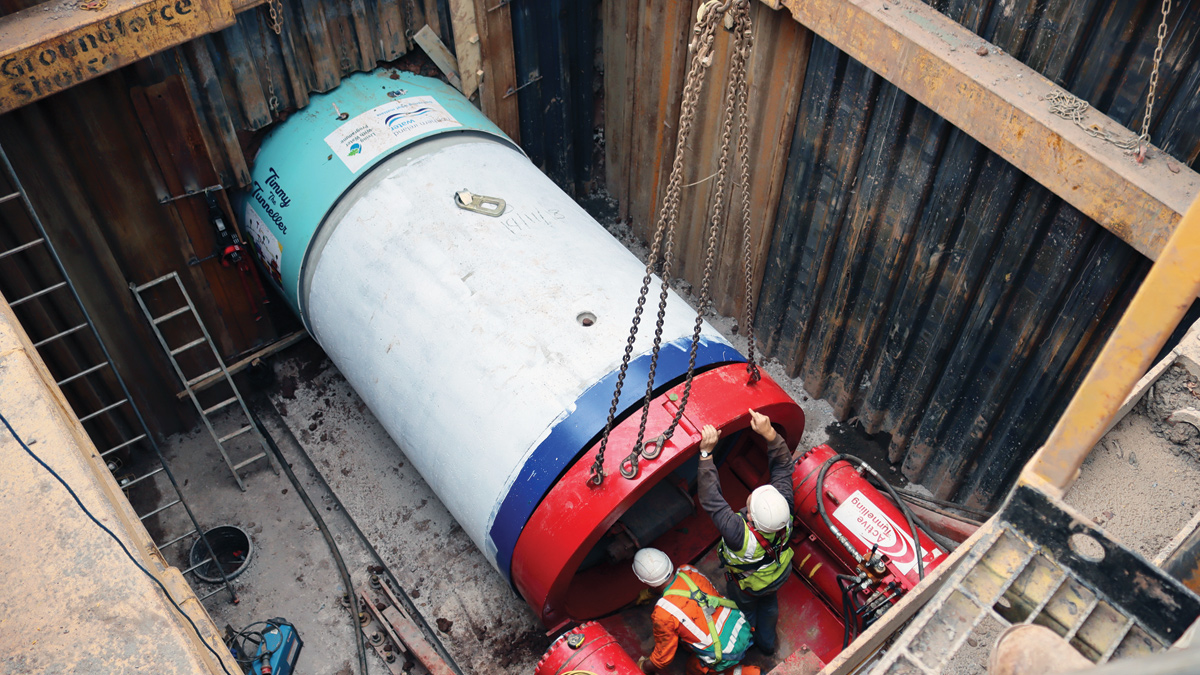
1800mm jacking pipe positioned in drive shaft at Ravenhill Avenue - Courtesy of NI Water and GEDA Construction
Ravenhill Avenue is located in south Belfast, close to the city centre. It is a densely populated residential area which has seen recent development of historically industrial sites. The sewer infrastructure in Ravenhill Avenue dates back to the early 20th century, and is therefore in poor condition and undersized to deal with today’s flows. Unfortunately, in recent years, customers have experienced flooding of their properties during heavy rainfall when the combined sewers fill with stormwater. As part of Belfast’s strategic ‘Living With Water Programme’, NI Water is currently investing £7m to upgrade the existing infrastructure at Ravenhill Avenue and in doing so reduce the risk of out-of-sewer flooding.
Undertakings
NI Water used existing framework partners to help develop and deliver a solution to alleviate the flooding in the Ravenhill Avenue area. A drainage model of the area was developed by Atkins, which confirmed that 12 properties in the Ravenhill Avenue area could be flooded during a 1 in 30 year storm event. This corresponded with the historic flooding reported by customers.
Atkins then developed a solution which would resolve the predicted flooding, involving a major upgrade of the existing sewer infrastructure to provide added capacity in the local network, whilst also removing storm flows from the combined network. AECOM were appointed to develop the proposals and investigate any alternative solutions. GEDA Construction were then selected to undertake ECI site investigations to determine ground conditions and assess the condition of the existing sewer network. GEDA Construction also assisted with the development of the proposals, providing input on the constructability of the scheme from an early stage.
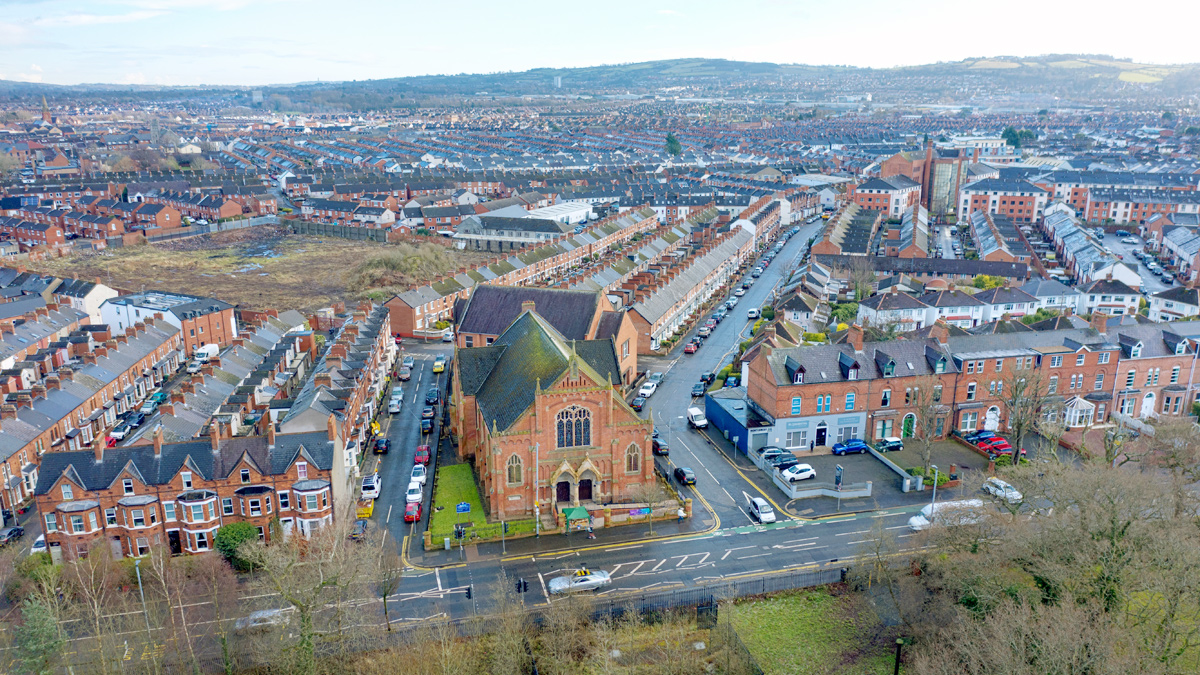
View of Ravenhill Avenue and Ravenhill Road from the edge of Ormeau Park – Courtesy of NI Water and GEDA Construction
The solution
The optimum design involves replacing the existing 1050mm concrete sewer and 700mm brick sewer on Ravenhill Avenue with a new 1800mm combined sewer to provide additional network capacity. A new 900mm storm sewer is to be laid adjacent to the 1800mm combined sewer to take storm flows from the new housing developments on Ravenhill Avenue and the surrounding area. Existing abandoned twin outfall pipes are to be reused to transfer the storm flows from Ravenhill Avenue through Ormeau Park to discharge into the River Lagan.
It was highlighted during the ECI phase/design development that laying a new 1800mm combined sewer up to 7m deep across Ravenhill Road and along Ravenhill Avenue would face a number of challenges and cause severe disruption to the public. In order to minimise disruption, it was determined that it would be best to tunnel the deepest section of 1800mm pipe, which crosses the Ravenhill Road from Ormeau Park (Florida CSO) to Ravenhill Avenue. In doing so, traffic on Ravenhill Road, a main route into Belfast city centre, would not be impacted and the construction risks involved in laying a sewer 7m deep in a residential area would be minimised.
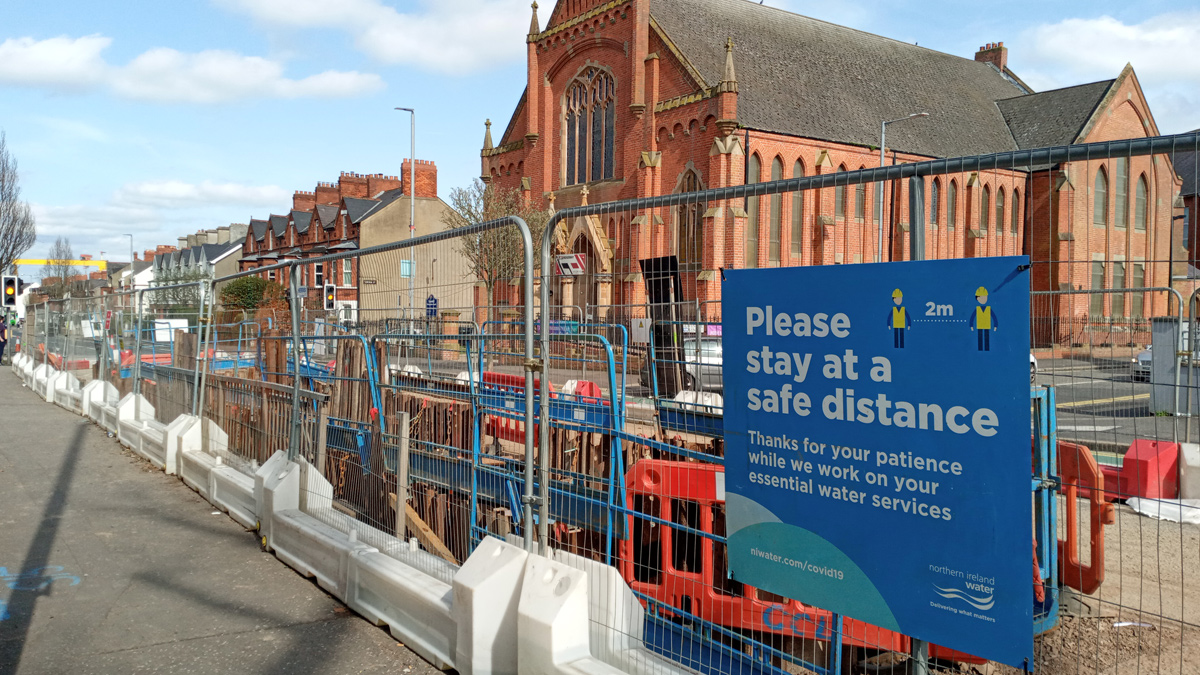
Site notice for works during Covid 19 – Courtesy of NI Water and GEDA Construction
Construction phase
For the main construction phase of the project, NI Water achieved continuity by retaining the same framework partners. AECOM were appointed under a NEC4 PSC Option A Contract to provide project management, cost management and site supervision services. GEDA Construction were appointed under a NEC4 ECC Option C Contract to upgrade the existing sewer network, and in doing so, alleviate flooding in the Ravenhill Avenue area.
Coventry-based Active Tunnelling were contracted by GEDA Construction to tunnel the new 1800mm diameter combined sewer below the busy Ravenhill Road to help minimise disruption during construction.
The tunnel method selected was open face shield pipe jacking. An open face shield is a type of tunnelling machine that has no frontal support and is used in trenchless tunnel excavation with either manual or machine digging. It was selected due to the favourable ground conditions identified during the site investigations, which was made up of firm stiff clay with no presence of groundwater. The open face machine was also ideal for dealing with the existing 1050mm concrete sewer and any unforeseen structures which may be encountered during the drive. The tunnel design and settlement calculations were completed for the open face shield by Active Tunnelling and their designers BSP Consulting.
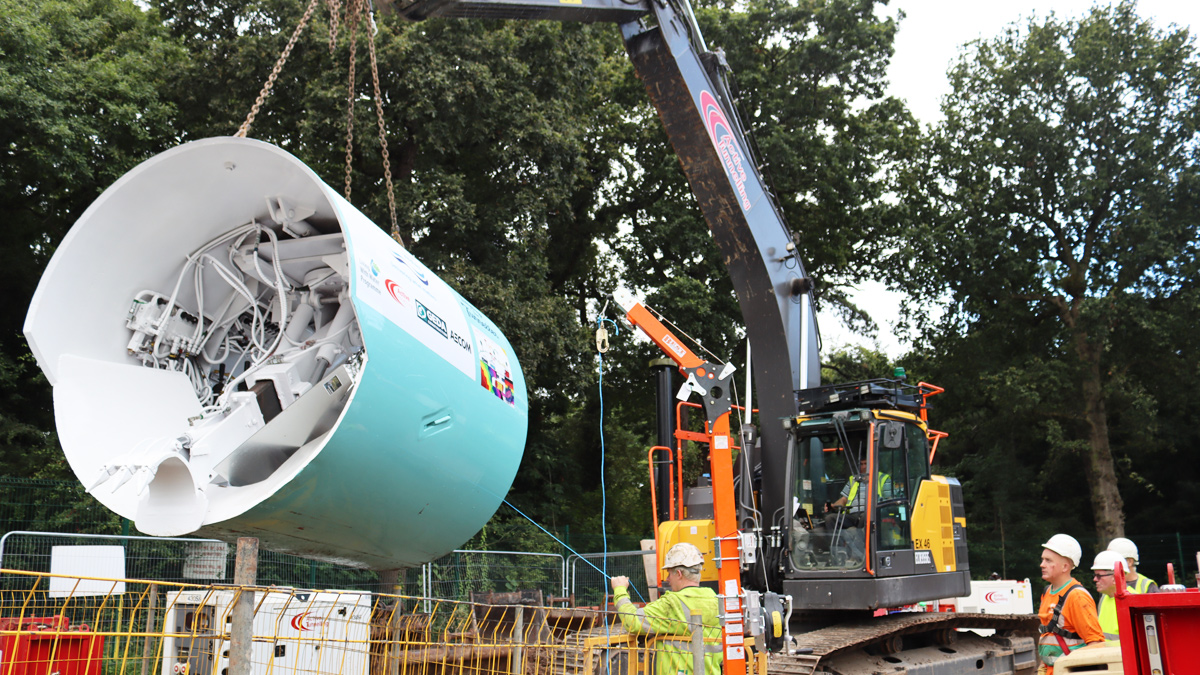
Tunnelling shield lifted into drive shaft at Ormeau Park – Courtesy of NI Water and GEDA Construction
The first activity was to set up traffic management and safe working areas with access for plant, equipment and operatives, both within Ormeau Park and Ravenhill Avenue. Due to the restricted urban environment and size of the new sewer infrastructure, the existing sewers had to be replaced online, which created additional challenges around dealing with the large volume of flows (1600l/s during a 1 in 5 year storm event) and an ageing egg-shaped brick sewer which was in poor condition.
Temporary works
Significant enabling works were therefore required before commencing with the tunnelling works. The new 1800mm tunnel would replace the existing 1050mm sewer, so the flows had to be diverted away from the existing 1050mm sewer. This was achieved by installing temporary manholes and cross connections between the existing sewers. The 1050mm sewer was then blocked and a portion of the flows (800l/s) were diverted via the existing egg-shaped brick sewer.
The remaining 800l/s was dealt with by means of a temporary pumping station with 5 (No.) pumps (2 (No.) 6” pumps, 2 (No.) 8” pumps and 1 (No.) 12” electric pump) and rising main which discharged downstream of the tunnelling works. The pumping station was setup to be fully automatic where pumps would only come on when flows increased up the barber pole. The setup also had GSM telemetry which would alert the site team if there was an issue such as pump failure or high water levels.
As the new 1800mm combined sewer followed a dog-leg in Ravenhill Avenue, it was tunnelled in two straight drives from drive pits at either end towards a reception pit located at the bend. Groundforce was employed early in the design process to provide temporary works design for the two drive pits and the reception pit. A cofferdam was constructed at each pit to withstand the ground pressures, and in the case of the two drive pits, an allowance was made for the jacking forces being transferred by the tunnelling operations into the rear jacking wall.
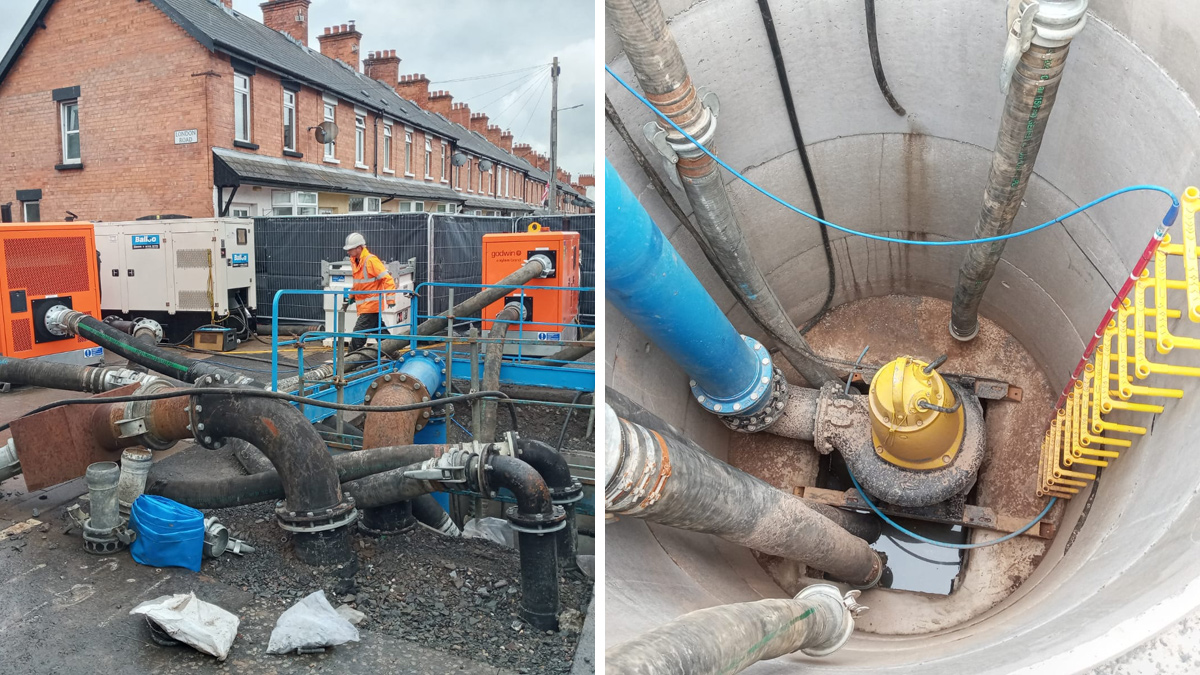
Temporary pumping station at London Road – Courtesy of NI Water and GEDA Construction
In each excavation the bearing capacity of the three Maxi Brace propping frames increased with the depth of the excavation: 260mm-wide Maxi 4 leg braces, the lightest in the range, were installed at the top of the excavation; Maxi 5 leg frames, also 260mm-wide but heavier, were installed half-way down, and Maxi 8R leg braces, 350mm-wide were installed at the bottom.
The drive and reception pits were designed so that the tunnelling machine and 1800mm jacking pipes could be lifted into the excavation without encountering any obstacles. Once the 200mm concrete base slab had achieved 10KN strength, the lowest propping frame could be removed and six of the steel sheet piles could be lifted to allow the tunnelling machine to exit/enter the pit.
Ravenhill Avenue Flood Alleviation Project: Supply chain – key participants
- Client: NI Water
- NEC Project Manager: AECOM
- Modelling: Atkins
- Designer: McAdam
- Geotechnical design: Cassidy Geotechnical
- Principal contractor: GEDA Construction
- Tunnelling contractor: Active Tunnelling
- Tunnelling design: BSP Consulting
- Temporary works: Groundforce
- Pipe laying contractor: Campbell Contracts
- Traffic management: Graham Asset Management
- Precast concrete: Tracey Concrete
- Pipeline supplier: APP Fusion Group
- Materials supplier: McNaughton & Blair
Tunnelling
With the existing 1050mm combined sewer diverted, the tunnel operations could commence. A drive pit measuring 6m x 5m x 6m deep was excavated on the edge of Ormeau Park beside Ravenhill Road. The jacking wall, tunnel jacking rams, and support equipment were then installed. The 1800mm jacking pipes supplied by Tracey Concrete were lifted into the pit and set onto the jacking rails.
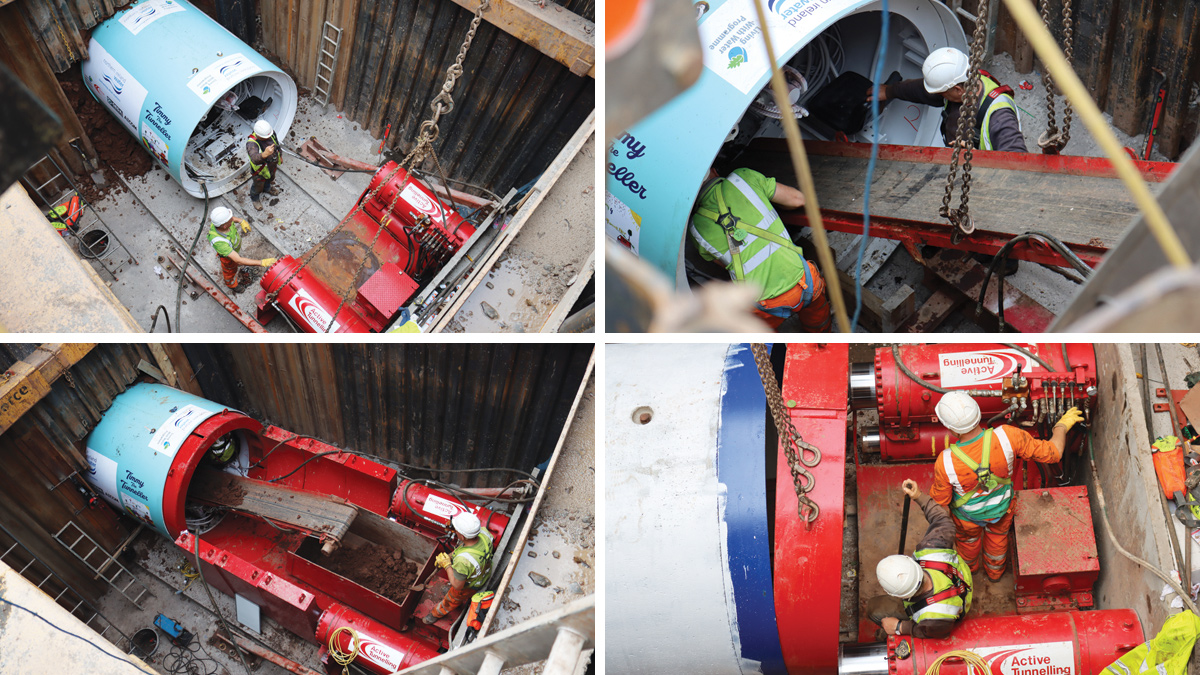
Pipe jacking sequence – Courtesy of NI Water and GEDA Construction
After the first jacking pipe had been driven and the tunnelling operation was in progress, works started on the reception pit and the second drive pit located on Ravenhill Avenue. Cofferdams 2 and 3 were smaller in footprint, 5.5m x 3.5m due to their proximity to Ravenhill Presbyterian Church, which also meant that careful daily monitoring was required to ensure minimal ground movement.
The two tunnel drives totalled 75m in length and a tolerance of only 10mm was achieved between both drives. On completion of each drive, the annulus was grouted up and the tunnelling machine and equipment removed from the pits. This allowed the pipeline sub-contractor, Campbell Contracts, to construct the manholes in each cofferdam, connecting the two tunnel drives with the existing sewer network. The completed tunnel was then inspected and brought straight into service allowing the temporary pumping station to be decommissioned.
Stakeholder engagement
As with all construction projects in public areas, stakeholder and customer engagement is key to delivering a successful outcome. A stakeholder and communications engagement plan was developed in the planning stages of the programme that focused on a joined-up approach with the project team. The aim of the plan was to establish, develop and deliver a clear, consistent and joined up programme of communication and consultation which identified target audiences at the appropriate stages of the construction process.
Due to the ongoing pandemic and initial lockdown procedures, initial community information sessions were not possible. In response to this challenge, a virtual room was developed which could be accessed online which housed a great deal of information regarding the project background, construction works and the aims of the project (www.ravenhillavenue.com). The virtual room also included a mechanism for feedback which was monitored regularly and responded to in a timely manner. Information on how to access the virtual room was included on all hard copy media including the letter drops which were sent directly to stakeholders and residents, as well as being posted on community and site noticeboards.
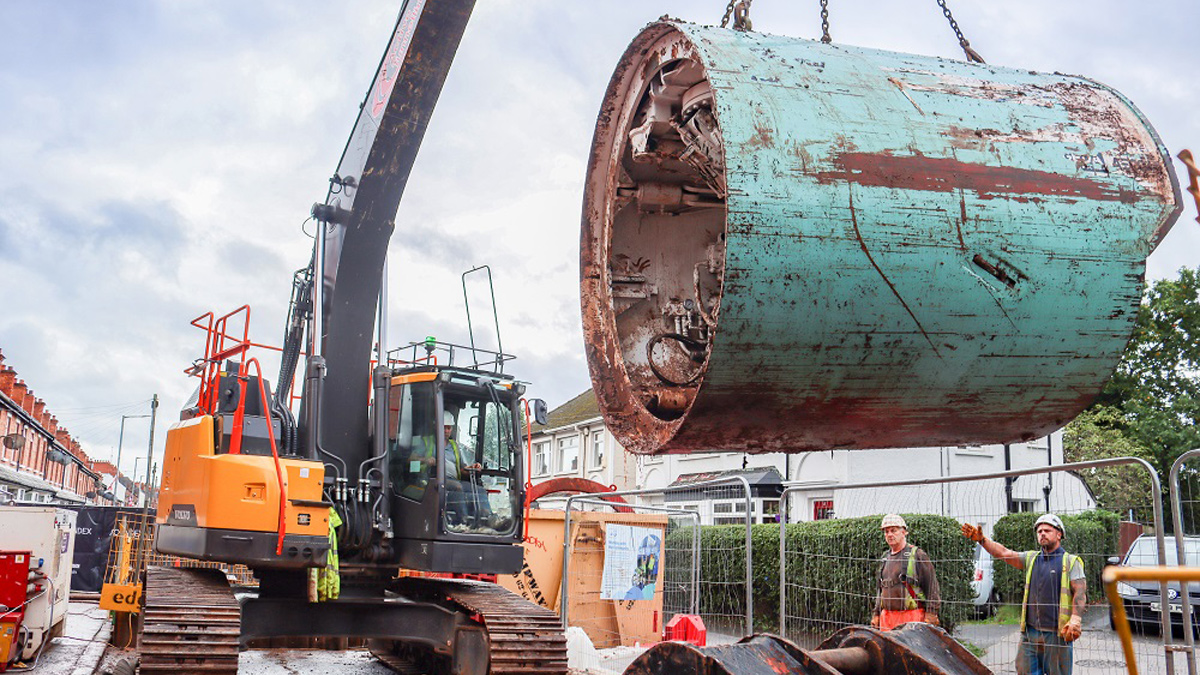
Tunnelling shield lifted out of reception shaft – Courtesy of NI Water and GEDA Construction
As part of the virtual room content, videos were posted throughout the project to update residents and stakeholders on the progress of the works and dates and durations of the various phases. This was updated as the programme progressed and was an effective tool in communicating future plans to the public. It contained local maps and indicators of where the work was taking place.
Community engagement was a major component on this project, with many activities being carried out with the local community and local schools. Health and safety talks were delivered to three local primary schools along with student activity packs. As a follow up for their learning, the pupils all took part in a poster competition to display what they learned, the winners were awarded with a medal and their artwork displayed on the compound site fencing. Careers in Construction talks were delivered to two secondary schools which included a visit to site for the students.
A water butt was donated to all five local schools, as well as the donation of a water feature by the contractor to one of the secondary schools. Other projects for the primary schools included creating artwork for the site hoarding and a competition to ‘name the tunnelling machine’ during our tunnelling works. A garden project was also carried out for the local special needs school. For the wider community, food collections were organised by the whole project team for the local food bank and a local church food drive.

School poster competition – Courtesy of NI Water and GEDA Construction
During the works the NIFRS Specialist Rescue Team from Central Fire Station, Belfast, was contacted to arrange a mock rescue exercise on site. The specialist rescue team carry out rescue works all over Northern Ireland and the mock exercise was carried out to mimic a potential accident that could occur during tunnelling operations. A public liaison officer was available on site to answer any specific concerns and personal visits were undertaken throughout the project by the public liaison officer where stakeholders were directly affected by specific works. The project team would like to thank the local residents and businesses for their ongoing cooperation as this project continues.
Ongoing works
Now the tunnelling works have been completed, open cut work to lay the new 1800mm combined sewer and 900mm storm sewer up Ravenhill Avenue and connect to the adjoining streets is currently ongoing. Once complete, the scheme will reduce the risk of out-of-sewer flooding in the Ravenhill Avenue area. Whilst also removing storm flows from the combined network, reducing the volume of flow which goes for treatment.
Conclusion
Successful delivery of this solution to reduce the risk of out-of-sewer flooding and protect the environment required careful planning and coordination from the entire project team to minimise disruption and inconvenience to the local community.








